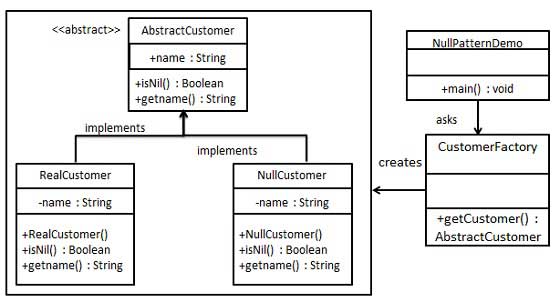设计模式 - 空对象模式
在空对象模式(Null Object Pattern)中,一个空对象取代 NULL 对象实例的检查。Null 对象不是检查空值,而是反应一个不做任何动作的关系。这样的 Null 对象也可以在数据不可用的时候提供默认的行为。
在空对象模式中,我们创建一个指定各种要执行的操作的抽象类和扩展该类的实体类,还创建一个未对该类做任何实现的空对象类,该空对象类将无缝地使用在需要检查空值的地方。
实现
我们将创建一个定义操作(在这里,是客户的名称)的 AbstractCustomer 抽象类,和扩展了 AbstractCustomer 类的实体类。工厂类 CustomerFactory 基于客户传递的名字来返回 RealCustomer 或 NullCustomer 对象。
NullPatternDemo,我们的演示类使用 CustomerFactory 来演示空对象模式的用法。

步骤 1
创建一个抽象类。
AbstractCustomer.java
package com.example.dsigin.nul; public abstract class AbstractCustomer { protected String name; public abstract boolean isNil(); public abstract String getName(); }
创建扩展了上述类的实体类。
RealCustomer.java
package com.example.dsigin.nul; public class RealCustomer extends AbstractCustomer { public RealCustomer(String name) { this.name = name; } @Override public String getName() { return name; } @Override public boolean isNil() { return false; } }
NullCustomer.java
package com.example.dsigin.nul; public class NullCustomer extends AbstractCustomer { @Override public String getName() { return "Not Available in Customer Database"; } @Override public boolean isNil() { return true; } }
创建 CustomerFactory 类。
CustomerFactory.java
package com.example.dsigin.nul; public class CustomerFactory { public static final String[] names = {"Rob", "Joe", "Julie"}; public static AbstractCustomer getCustomer(String name){ for (int i = 0; i < names.length; i++) { if (names[i].equalsIgnoreCase(name)){ return new RealCustomer(name); } } return new NullCustomer(); } }
步骤 4
使用 CustomerFactory,基于客户传递的名字,来获取 RealCustomer 或 NullCustomer 对象。
NullPatternDemo.java
package com.example.dsigin.nul; public class NullPatternDemo { public static void main(String[] args) { AbstractCustomer customer1 = CustomerFactory.getCustomer("Rob"); AbstractCustomer customer2 = CustomerFactory.getCustomer("Bob"); AbstractCustomer customer3 = CustomerFactory.getCustomer("Julie"); AbstractCustomer customer4 = CustomerFactory.getCustomer("Laura"); System.out.println("Customers"); System.out.println(customer1.getName()); System.out.println(customer2.getName()); System.out.println(customer3.getName()); System.out.println(customer4.getName()); } }
步骤 5
执行程序,输出结果:
Customers
Rob
Not Available in Customer Database
Julie
Not Available in Customer Database
作者:guanbin —— 纵码万里千山
出处:https://www.cnblogs.com/guanbin-529/
本文版权归作者和博客园共有,欢迎转载,但未经作者同意必须保留此段声明,且在文章页面明显位置给出原文连接,否则保留追究法律责任的权利。


